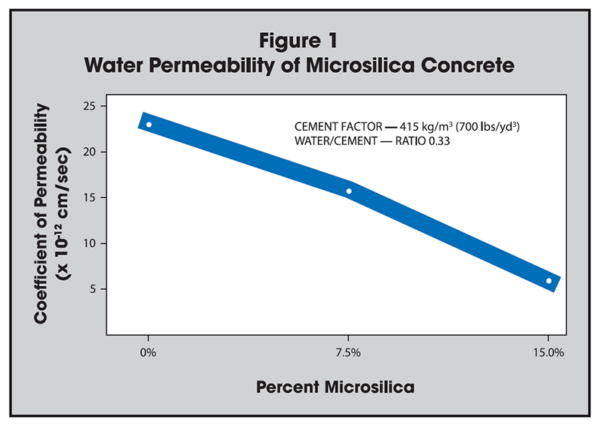Water and Gas Permeability of FORCE 10,000® D Microsilica Concrete – TB-0711

There are many applications in industry which require a concrete with very low permeability. Structures where contamination from either the inside or outside is critical — such as waste water treatment plants or water containment vessels — may need such protection. Tunnel linings also may require a less permeable concrete to protect against water seepage and permeation of certain gases. Additionally, reduced permeability is important in structures which are in environments exposed to salts — both road and marine — where the salts eventually migrate into the concrete and initiate corrosion of reinforcing steel.
In all of these applications, FORCE 10,000® D, a microsilica-based concrete admixture, can provide reduced permeability through two different mechanisms. First, the fine particle size of the microsilica (one-hundredth the size of cement grains) acts to fill in potential voids or gaps within the matrix. Second, the pozzolanic microsilica combines with the free lime (calcium hydroxide) in the concrete system to produce additional paste (calcium- silicate-hydrate), providing better bonding between the aggregates, and reducing the potential for creation of “transmission” channels. Thus the permeation of liquids and gases can be significantly reduced versus conventional concrete.
This technical bulletin describes the results from both water and gas permeability tests run on FORCE 10,000® D Microsilica Concrete.
(In reference to the permeability of chlorides, FORCE 10,000® D not only reduces concrete permeability, but also increases resistivity, thus reducing the concrete’s ability to pass electrical currents and impeding the corrosion process. For more information see FORCE 10,000® D Technical Bulletin 0712.)
Water Permeability
To evaluate the water permeability of FORCE 10,000® D Microsilica Concrete, GCP Applied Technologies contracted an independent testing agency, Law Engineering, to perform the standard U.S. Army Corps of Engineers Test CRD-C48-73, “Method of Test for Water Permeability of Concrete.” Basically, the test involves placing a specific head pressure on the concrete specimen and measuring the flow rate of water through this specimen over time. Once a stable rate is achieved, the permeability coefficient of the specimen can be calculated by applying d’Arcy’s law for unidirectional flow at constant head pressure.
In this particular test the concrete was exposed to head pressures of 1.66 MPa (240 psi) (or about 16 atmospheres). The specimens, with a 150 mm (6 in.) diameter, were cast at GCP’s lab, and given to Law Engineering for testing.
The three comparison samples each had 415 kg/m3 (700 lbs/yd3) of cement and a water/cement ratio of 0.33. The microsilica dosages were 0%, 7.5%, and 15% by weight of cement.
The permeability results of the three mixes are shown below in Figure 1:
As shown, the coefficient of permeability of the concrete decreased significantly with the addition of microsilica: by 30% for a 7.5% dosage rate, and by 73% for the 15% dosage rate. The microsilica concrete values were both below 20×10-12 cm/sec, which is considered to be very low permeability for concrete.
In addition to this work performed by Law Engineering, others have conducted tests with similar results. E. J. Sellevold, of the Norwegian Building Research Institute, concluded from a review of European lab and field data that for equal compressive strength levels, concrete with microsilica is more impermeable than ordinary portland cement concrete. From this he concluded that the “efficiency” factor for microsilica in concrete is greater with respect to permeability than to compressive strength (Effect of Microsilica on the Durability of Concrete Structures, Concrete International, December 1987, p. 39-43).
Gas Permeability
We have also examined the permeability of microsilica concrete to methane and nitrogen gases. The test used, developed by Matrecon, Inc., compares the gas permeability of


concrete at pressures ranging from 34 to 210 kPa (5 to 30 psi). While testing is still continuing, Matrecon concluded that microsilica significantly reduced the permeation of methane gas through the concrete, as shown in Figure 2.
Methane transmission rates, measured in milliliters per day, were significantly reduced for the microsilica concrete at all pressure levels tested between 34 to 210 kPa (5 to 30 psi). Significant benefits are shown at lower pressures 34 kPa (5 psi) which more accurately reflects conditions likely to be encountered in a tunnel environment.
Summary
As shown in the previous two figures, FORCE 10,000® D Microsilica can significantly reduce the permeability of concrete to both liquids and gases. At dosages of 15% microsilica by weight of cement, the water permeability was reduced by over 70% versus the reference. Similarly, methane gas transmission rates were more than halved with microsilica concrete. In applications where water and gas permeability reductions are important, such as tunnel linings and storage vessels, FORCE 10,000® D can be used to improve the concrete properties.


